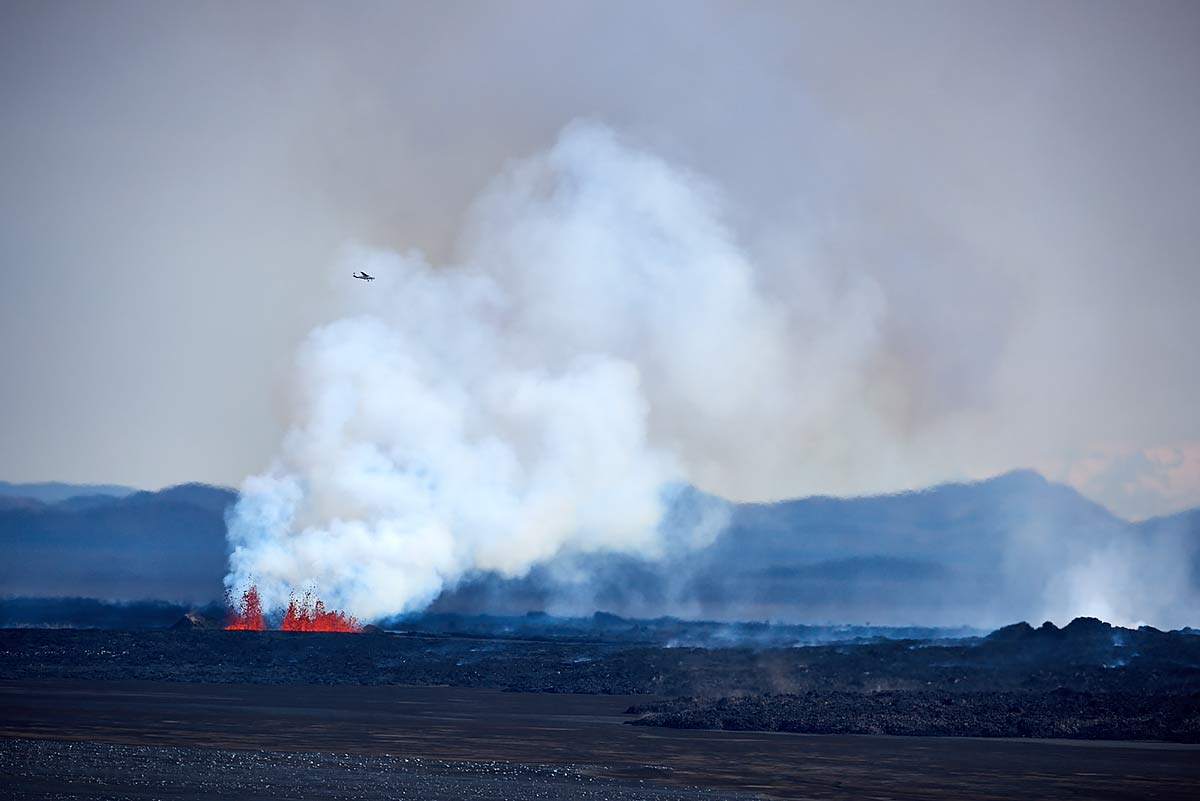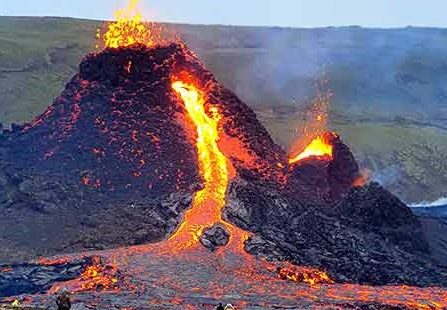Iceland’s reputation for frequent volcanic activity is once again reinforced as we witness the emergence of a new volcano in the Reykjanes Peninsula. This phenomenon can be attributed to Iceland’s unique position atop the continually spreading Mid-Atlantic Ridge. This ridge stretches over 40,000 kilometers, representing a divergent boundary between the North American and Eurasian tectonic plates, and forms a substantial crack in the ocean floor.
The newest volcano eruption in Iceland in Litli Hrútur
On July 10, 2023, a new volcanic eruption started in the vicinity of Fagradalsfjall. The eruption originated from a 900-meter-long fissure situated near Litli-Hrútur Mountain. Remarkably, this is the 3rd year in a row that a volcano eruption has taken place in Reykjanes Peninsula.
Notably, the new eruption occurred slightly north of the previous two events, aligning with scientists’ expectations based on meticulous surveys conducted in the area. The past two eruptions, Fagradalsfjall in 2021 and Meradalir in 2022, a now the third one took place on the 10th of July, 2023. It was the first volcanic eruption in the region in nearly 800 years. It’s extremely difficult to forecast how long the eruption will continue or how much lava it can produce.
Situated approximately 30 kilometers (19 miles) southwest of Reykjavík, the eruption poses no threat to residential areas or infrastructure. The flows are currently confined to empty valleys, with no major infrastructure nearby. Also absent are bodies of water or ice, which can sometimes trigger a series of violent, ash-heavy explosions. Thankfully, there have been no disruptions to international or domestic flights, ensuring normalcy in air travel operations.

Volcano erupt for 3rd time in 3 years in Iceland
Over the past two years, the Reykjanes Peninsula has experienced significant volcanic activity. On March 19, 2021, following a series of thousands of earthquakes in the preceding days, a fissure vent opened in Geldingadalir, located just south of Fagradalsfjall mountain. This previously dormant, flat-topped volcano and its surrounding volcanic systems had remained inactive for an impressive period of 815 years. However, it spectacularly came to life as magma, reaching temperatures exceeding 1,300°C (2372°F), was forcefully ejected into the air. The lava spewed up to 100 meters high from a newly formed fissure near Fagradalsfjall. The eruption spread across a 1-km-long rift, filling the Geldingadalur valley with lava and creating a beautiful spectacle. The eruption was named Fagradalsfjall or Geldingadalir eruption. The awe-inspiring sight could be witnessed from Reykjavík, more than 40 kilometers away.
Subsequently, on August 3, 2022, following a similar swarm of earthquakes to the 2021 eruption, a 300-meter-long fissure opened in an adjacent valley known as Meradalir Valley. This eruption persisted for several weeks, culminating on August 21, 2022, and resulted in the valley being filled with fresh lava. Concerns that the eruption might spill beyond the valley towards the road below were alleviated as the volcanic activity ceased shortly after it commenced.
Then, in July 2023, the third volcano erupted, much like its two recent predecessors, continuing the series of volcanic events in the area close to Litli Hrútur Mountain.

What is the frequency of volcanic activity in Iceland?
Iceland experiences a relatively high frequency of volcanic activity compared to many other regions in the world. Iceland is one of Earth’s most volcanically active regions on the planet, and on average, there is an eruption in Iceland every three to five years. However, it’s important to note that volcanic activity can vary greatly in intensity and duration. Some eruptions may be relatively small and short-lived, while others can be larger and last for several months or even years.

Iceland – The land of future active volcanoes
The recent eruption in Iceland could potentially mark the beginning of a prolonged period of volcanic activity. With three lava outbursts occurring within the past three years, it strongly indicates that the Reykjanes Peninsula will become one of the most geologically dynamic regions on Earth for many generations to come.
If this signals the onset of a new era of volcanic activity in Reykjanes, it is challenging to foresee the implications for the local inhabitants. The precise location and timing of future eruptions remain uncertain at present, making it impossible to predict where or when the next volcanic event may occur.
How to get to the newest Volcanic eruption in Iceland
While the volcanic eruption is a magnificent sight, it is important to exercise caution and take necessary safety measures. When exploring Iceland’s natural wonders, it is crucial to be well-prepared and informed before embarking on your journey.
During daylight hours, the eruption is highly visible and can be observed clearly through a live stream from the area. If you plan to visit the Litli-Hrútur volcano, ensure that you dress appropriately for the conditions and familiarize yourself with the potential hazards associated with the eruption.
To reach the newest volcanic eruption site in Iceland, you can easily access it from Reykjavík, with Grindavík located on the south coast in proximity. The drive from Reykjavík typically takes around an hour, while the journey from Keflavík usually lasts approximately 45 minutes.
And of course, it is convenient to stay at the Nordic Lodges that are in a safe distance from the eruption, like at Brekka & Langholt and Stekkar Lodges.

